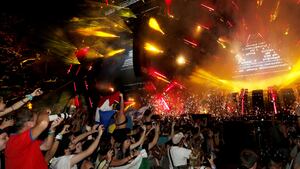For a subset of the dance music world, the third (or fourth) weekend in March arrives like the highest of holy days, when a crowd of some 170,000 descends on Bayfront Park in Miami for Ultra Music Festival, the 72-hour spectacle that helped make EDM a mainstream American genre. Under normal circumstances, Ultra would have ended yesterday. But after the novel coronavirus triggered closures across the country, the concert was cancelled. Instead, the festival migrated online, announcing a weekend marathon of live DJ sets on SiriusXM. The digital concert would essentially be radio, but rebranded as an upgrade: the “Ultra Virtual Audio Festival.”
Ultranauts, as the corporation calls its fans, did not love the new plan. A day after the new format was announced, Facebook groups popped up calling for diehards to “Storm Ultra 2020, They Can’t Quarantine All of Us,” as one event page put it. “Bring your wireless speakers, friends, hydration packs, kandi, flags and PLUR vibes to Bayfront park,” the moderator wrote. “Facemasks encouraged.”
That page drew over 1,000 interested attendees, until Facebook intervened (“So it turns out,” a would-be guest noted, “they really can quarantine us all.”) Instead, on Friday evening, as 75 million Americans settled in for another night of social distancing, the Ultranauts logged on. “What dimensions does my hydration pack need to be to get in?” a user called X-Mang asked the festival subreddit. “Fuck it,” user joeschmo28 answered. “I’m wearing mine during the livestream.”
Ultra wasn’t confronting the novel coronavirus alone. As venues shuttered across the country last week, the music industry reeled. Artists begged fans to buy merch; concert halls set up online fundraisers for laid-off staff; Bandcamp waived its revenue shares to send more money to musicians; and stars from Charli XCX to Neil Young held live-streamed concerts, so many that Billboard keeps a running list. But the Ultra Virtual Audio Festival seemed to exist on a separate plane, not just because the company has no financial woes and a spotty record regarding public health mandates. Their attempt to go virtual struck a symbolic note because of the echoes between the global festival’s rise and the technology and economics that shaped American life in the new millennium.
For nearly two decades, the outdoor electronic spectacle has charted a course of nearly unrelenting growth. Born in 1999 on a Miami beach, the festival named for Depeche Mode’s album Ultra started as a single-day off-shoot of the once-venerable industry confab, Winter Music Conference. The first Ultra wasn’t so much a festival as a party—a low-budget sideshow produced on a $10,000 bank loan with none of the pyrotechnics or big names it boasts now. But it grew rapidly, adding days, attendees by the thousands, and spinoff events in 29 countries. In the mid-aughts, Ultra overtook its father festival; in 2011, it split from the conference officially; in 2018, it swallowed WMC whole. When I covered Ultra that year, some 165,000 people packed into Bayfront Park and over 30 million watched from home—more than the population of Australia. Ultra Worldwide has not disclosed its revenue or profit margins, and did not respond to comment for this article. But weekend passes start at $399, VIP packages run upwards of $850, and a 2012 study, commissioned with Ultra Music Festival money, found the Miami event alone generated $79 million in annual economic impact.
As Ultra grew, so did EDM. In 1999, rave scenes and electronic subgenres had proliferated in the United States for decades, but never like Europe, where house and techno had taken hold, and never in the commercial mainstream, averse to the drug-culture association. After the turn of the century, that began to change. In 2004, the Dutch producer and frequent Ultra performer Tiësto became the first DJ to play at an Olympic opening ceremony, performing a 90-minute set before an audience of millions. Just two years later, Daft Punk played at Coachella, heralding a “new era in American electronic dance music,” as SPIN wrote at the time. The phrase “EDM” began to overtake “dance music,” in what some critics described as an attempt to erase the latter’s association with drug use.
Part of the genre’s newfound commercial appeal came from the profit margins of its live events. “Promoters make a lot more money on the DJ shows,” Diplo told SPIN. “A band plays, it’s 45 minutes; DJs can play for four hours.” Corporations noticed. In 2012, Live Nation founder Robert Sillerman announced plans to acquire $1 billion worth of EDM businesses, launching the genre conglomerate SFX Entertainment, which now owns Ultra competitors Tomorrowland and Electric Zoo. Advertisers from Heineken to Olay to Fiji water to G-Star Raw commissioned EDM artists and festivals for commercials or sponsorships. By the mid-2010s, the commercialization of EDM was so well-established it got its own SNL sketch. The year after, Warner Bros. released the EDM film We Are Your Friends, starring Zac Efron as a DJ trying to make it big.
But if EDM is the soundtrack of capital, it is also the score of big tech—of video games, wireless headphones, social media, and startups. In some ways, EDM might be the genre best suited for a Virtual Audio Festival: Ultra has been livestreaming its festivals since 2012, broadcasting on Twitch since 2015, and playing music on FM radio to 22 million weekly listeners in 62 different countries. In Anna Wiener’s memoir Uncanny Valley, about working at a start-up in the mid-2010s tech bubble (which overlapped, incidentally, with EDM’s own bubble), she describes hearing her co-workers’ EDM through their headphones. “It was a vestige of Burning Man that never went out of season in the Bay Area, like ecstatic dance or LED-studded sculptures or psychedelic leggings,” Wiener recalls. “It was the genre of my generation: the music of video games and computer effects, the music of the twenty-four hour hustle, the music of proudly selling out.”
But the Ultra Virtual Audio Festival wasn’t a feat of hustle culture or selling out. It was, simply, radio. No lasers or high-production; not even new production. (Fans complained on Reddit that some of the sets were recycled recordings from earlier years). If Wiener was right, that EDM was “the music of ahistory, or globalization—or maybe nihilism, but fun,” Ultra’s attempt at virtuality illustrated what happens when the vehicle of that nihilism, the global economy, grinds to a halt. However grim it might have seemed before, the end result is weirder still. “This,” a user called historicalfigure9 wrote on the subreddit, “is depressing.”


